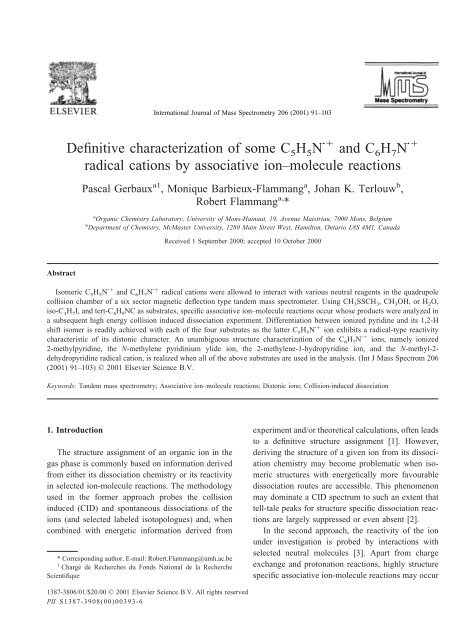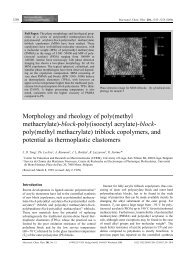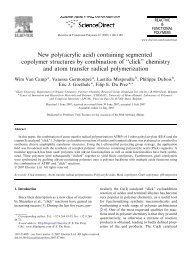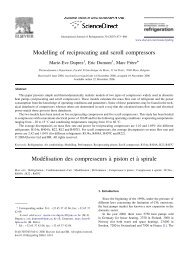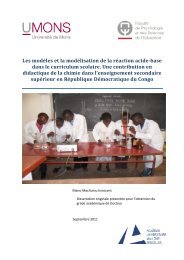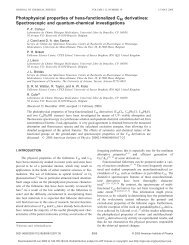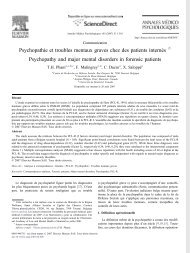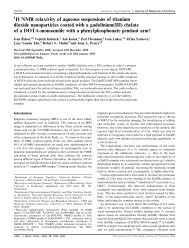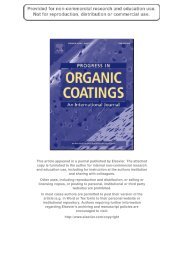Definitive characterization of some C5H5N and C radical cations by ...
Definitive characterization of some C5H5N and C radical cations by ...
Definitive characterization of some C5H5N and C radical cations by ...
You also want an ePaper? Increase the reach of your titles
YUMPU automatically turns print PDFs into web optimized ePapers that Google loves.
International Journal <strong>of</strong> Mass Spectrometry 206 (2001) 91–103<br />
<strong>Definitive</strong> <strong>characterization</strong> <strong>of</strong> <strong>some</strong> C 5 H 5 N <strong>and</strong> C 6 H 7 N <br />
<strong>radical</strong> <strong>cations</strong> <strong>by</strong> associative ion–molecule reactions<br />
Pascal Gerbaux a1 , Monique Barbieux-Flammang a , Johan K. Terlouw b ,<br />
Robert Flammang a, *<br />
a Organic Chemistry Laboratory, University <strong>of</strong> Mons-Hainaut, 19, Avenue Maistriau, 7000 Mons, Belgium<br />
b Department <strong>of</strong> Chemistry, McMaster University, 1280 Main Street West, Hamilton, Ontario L8S 4M1, Canada<br />
Received 1 September 2000; accepted 10 October 2000<br />
Abstract<br />
I<strong>some</strong>ric C 5 H 5 N <strong>and</strong> C 6 H 7 N <strong>radical</strong> <strong>cations</strong> were allowed to interact with various neutral reagents in the quadrupole<br />
collision chamber <strong>of</strong> a six sector magnetic deflection type t<strong>and</strong>em mass spectrometer. Using CH 3 SSCH 3 ,CH 3 OH, or H 2 O,<br />
iso-C 3 H 7 I, <strong>and</strong> tert-C 4 H 9 NC as substrates, specific associative ion–molecule reactions occur whose products were analyzed in<br />
a subsequent high energy collision induced dissociation experiment. Differentiation between ionized pyridine <strong>and</strong> its 1,2-H<br />
shift i<strong>some</strong>r is readily achieved with each <strong>of</strong> the four substrates as the latter C 5 H 5 N ion exhibits a <strong>radical</strong>-type reactivity<br />
characteristic <strong>of</strong> its distonic character. An unambiguous structure <strong>characterization</strong> <strong>of</strong> the C 6 H 7 N ions, namely ionized<br />
2-methylpyridine, the N-methylene pyridinium ylide ion, the 2-methylene-1-hydropyridine ion, <strong>and</strong> the N-methyl-2-<br />
dehydropyridine <strong>radical</strong> cation, is realized when all <strong>of</strong> the above substrates are used in the analysis. (Int J Mass Spectrom 206<br />
(2001) 91–103) © 2001 Elsevier Science B.V.<br />
Keywords: T<strong>and</strong>em mass spectrometry; Associative ion–molecule reactions; Distonic ions; Collision-induced dissociation<br />
1. Introduction<br />
The structure assignment <strong>of</strong> an organic ion in the<br />
gas phase is commonly based on information derived<br />
from either its dissociation chemistry or its reactivity<br />
in selected ion-molecule reactions. The methodology<br />
used in the former approach probes the collision<br />
induced (CID) <strong>and</strong> spontaneous dissociations <strong>of</strong> the<br />
ions (<strong>and</strong> selected labeled isotopologues) <strong>and</strong>, when<br />
combined with energetic information derived from<br />
* Corresponding author. E-mail: Robert.Flammang@umh.ac.be<br />
1 Chargé de Recherches du Fonds National de la Recherche<br />
Scientifique<br />
experiment <strong>and</strong>/or theoretical calculations, <strong>of</strong>ten leads<br />
to a definitive structure assignment [1]. However,<br />
deriving the structure <strong>of</strong> a given ion from its dissociation<br />
chemistry may become problematic when i<strong>some</strong>ric<br />
structures with energetically more favourable<br />
dissociation routes are accessible. This phenomenon<br />
may dominate a CID spectrum to such an extent that<br />
tell-tale peaks for structure specific dissociation reactions<br />
are largely suppressed or even absent [2].<br />
In the second approach, the reactivity <strong>of</strong> the ion<br />
under investigation is probed <strong>by</strong> interactions with<br />
selected neutral molecules [3]. Apart from charge<br />
exchange <strong>and</strong> protonation reactions, highly structure<br />
specific associative ion-molecule reactions may occur<br />
1387-3806/01/$20.00 © 2001 Elsevier Science B.V. All rights reserved<br />
PII S1387-3908(00)00393-6
92 P. Gerbaux et al./International Journal <strong>of</strong> Mass Spectrometry 206 (2001) 91–103<br />
that can serve to easily distinguish the ion from its<br />
structurally related i<strong>some</strong>rs. A couple <strong>of</strong> examples <strong>of</strong><br />
the success <strong>of</strong> this approach (where CID experiments<br />
were inconclusive) involve the differentiation <strong>of</strong> the<br />
C- <strong>and</strong> S-sulfide ethenedithione ions SCCS . 2 <strong>and</strong><br />
SCCSS . [4] <strong>and</strong> the <strong>characterization</strong> <strong>of</strong> i<strong>some</strong>ric<br />
C 4 H 4 ions [3e,5].<br />
On the other h<strong>and</strong>, the interaction <strong>of</strong> an ion with an<br />
appropriately chosen neutral molecule may also lead<br />
to a facile i<strong>some</strong>rization, <strong>by</strong> way <strong>of</strong> proton transport<br />
catalysis <strong>and</strong> related mechanisms [6]. Nevertheless,<br />
the virtually unlimited choice <strong>of</strong> neutral molecules<br />
makes the ion–molecule approach quite versatile <strong>and</strong><br />
eminently suited as a complementary tool to study<br />
systems <strong>of</strong> i<strong>some</strong>ric ions whose basic i<strong>some</strong>rization<br />
<strong>and</strong> dissociation characteristics have been probed <strong>by</strong><br />
theory <strong>and</strong>/or experiment.<br />
A case in point are the three 1,2-H shift i<strong>some</strong>rs <strong>of</strong><br />
the pyridine <strong>radical</strong> cation 1 which have been<br />
thoroughly characterized <strong>by</strong> various collision experiments<br />
<strong>and</strong> theoretical calculations [7]. The highenergy<br />
CID spectra <strong>of</strong> the four i<strong>some</strong>ric ions are<br />
similar but nevertheless characteristically different.<br />
For example, for ionized pyridine <strong>and</strong> its -distonic<br />
i<strong>some</strong>r 1a , the i<strong>some</strong>r distinction was realized on<br />
the basis <strong>of</strong> the m/z 28 (HC¢NH )/26 (HC§CH )<br />
peak branching ratio in their CID spectra: the pyridine<br />
<strong>radical</strong> cation is characterized <strong>by</strong> a ratio <strong>of</strong> 0.410.03<br />
whereas, in keeping with its structure, 1a yields a<br />
higher ratio: 0.860.03.<br />
However, as shown in a recent preliminary study<br />
[8], a far easier differentiation between these two<br />
C 5 H 5 N ions is obtained in an associative ionmolecule<br />
reaction with dimethyl disulfide as the<br />
neutral reagent. Considering the ionization energies<br />
(IEs) <strong>of</strong> 1a <strong>and</strong> 1 (6.8 <strong>and</strong> 9.3 eV [7]) vis à vis that <strong>of</strong><br />
the disulfide (8.0 eV [9]), the pronounced difference<br />
in reactivity between the two ions, viz. a facile CH 3 S <br />
abstraction for 1a <strong>and</strong> charge exchange for 1 ,<br />
becomes readily underst<strong>and</strong>able.<br />
Another prime c<strong>and</strong>idate for further analysis <strong>by</strong><br />
associative ion–molecule reactions concerns the related<br />
C 6 H 7 N system <strong>of</strong> ions, viz. ionized 2-methylpyridine,<br />
2 , <strong>and</strong> its i<strong>some</strong>rs, 2a , the N-methylene<br />
pyridinium ylide ion, 2b , the 2-methylene-1-<br />
hydropyridine ion, <strong>and</strong> 2c , the N-methyl-2-<br />
dehydropyridine <strong>radical</strong> cation (Scheme 1).<br />
As shown in a recent detailed experimental study<br />
[10], these four stable i<strong>some</strong>rs can be differentiated on<br />
the basis <strong>of</strong> small structurally characteristic intensity<br />
differences in their high-energy CID spectra but only<br />
when the spectra are obtained under exactly the same,<br />
carefully defined, experimental conditions.<br />
In light <strong>of</strong> the promising result on the pyridine<br />
system reported in [8], we report here a more detailed<br />
<strong>characterization</strong> <strong>of</strong> the C 5 H 5 N ions, 1 <strong>and</strong> 1a ,<br />
<strong>and</strong> also the C 6 H 7 N ions, 2 , 2a , 2b , <strong>and</strong> 2c <br />
<strong>by</strong> studying their associative ion–molecule reactions<br />
with several neutral reagents including water, methanol,<br />
dimethyl disulfide, pyridine-d 5 , isopropyl iodide,<br />
<strong>and</strong> tert-butyl isocyanide. Some <strong>of</strong> these molecules<br />
are recognized as excellent trapping agents <strong>of</strong> distonic<br />
ions [3a,3b].<br />
2. Experimental<br />
Scheme 1.<br />
The spectra were recorded on a six sector t<strong>and</strong>em<br />
mass spectrometer (Micromass AutoSpec 6F,<br />
Manchester) <strong>of</strong> E 1 c 1 B 1 c 2 E 2 c 3 c 4 E 3 B 2 c 5 E 4 geometry<br />
(E electric sector, B magnetic sector, c collision<br />
cell) [11]. General conditions were 8 kV accelerating<br />
voltage, 200 A trap current (in the electron<br />
ionization mode, EI), 1 mA (in the chemical ionization<br />
mode, CI), 70 eV ionizing electron energy <strong>and</strong><br />
200 °C ion source temperature. The solid samples<br />
were introduced with a direct insertion probe, while<br />
the liquid samples were injected into the ion source <strong>by</strong><br />
means <strong>of</strong> a heated (180 °C) septum inlet.<br />
The instrument has been modified with an rf-only
P. Gerbaux et al./International Journal <strong>of</strong> Mass Spectrometry 206 (2001) 91–103<br />
93<br />
quadrupole collision cell (Qcell) between E 2 <strong>and</strong> E 3 as<br />
reported elsewhere [12]. This modification allows the<br />
study <strong>of</strong> associative ion–molecule reactions <strong>and</strong> the<br />
study <strong>of</strong> collision induced dissociation <strong>of</strong> decelerated<br />
ions having 20–30 eV kinetic energy. Briefly, the<br />
experiments utilizing the quadrupole consist <strong>of</strong> the<br />
selection <strong>of</strong> a beam <strong>of</strong> fast moving ions (8 keV) with<br />
the three first sectors (E 1 B 1 E 2 ), the deceleration <strong>of</strong><br />
these ions to 5 eV (to maximize ion–molecule<br />
reactions) or 20–30 eV (to maximize collision induced<br />
dissociations). The interaction between the ions<br />
<strong>and</strong> the reagent gas (the pressure <strong>of</strong> the gas is<br />
estimated to be about 10 3 Torr) is thereafter realized<br />
in the Qcell <strong>and</strong>, after reacceleration to 8 keV, all the<br />
ions generated in the quadrupole are separated <strong>and</strong><br />
mass measured <strong>by</strong> scanning the field <strong>of</strong> the second<br />
magnet. The high-energy CA spectra <strong>of</strong> mass-selected<br />
ions generated in the Qcell can be recorded <strong>by</strong> a<br />
linked scanning <strong>of</strong> the fields <strong>of</strong> the three last sectors.<br />
The pressure <strong>of</strong> the neutral reagent in the quadrupole<br />
collision cell cannot be reliably measured as it is<br />
estimated using an ionization gauge situated quite far<br />
away from the quadrupole cell. For the sake <strong>of</strong><br />
consistency, an ion transmission <strong>of</strong> 50% was used in<br />
all experiments.<br />
All samples were commercially available (Aldrich,<br />
Resco Trade) <strong>and</strong> used without further purification,<br />
except for 2-methylthiopyridine [13a] <strong>and</strong> methyl-2-<br />
pyridinethiocarboxylate [13b] which were prepared<br />
according to literature procedures.<br />
3. Results <strong>and</strong> discussion: the C 5 H 5 N <strong>radical</strong><br />
<strong>cations</strong> 1 <strong>and</strong> 1a <br />
3.1. Preparation <strong>of</strong> the ions<br />
Pyridine molecular ions 1 are conveniently generated<br />
<strong>by</strong> electron ionization <strong>of</strong> neutral pyridine<br />
whereas the -distonic i<strong>some</strong>r 1a can be obtained<br />
<strong>by</strong> dissociative ionization from various precursor<br />
molecules. These include 2-picolinic acid (loss <strong>of</strong><br />
CO 2 ) [7a], methyl picolinate (loss <strong>of</strong> CH 2 ¢O CO)<br />
[7b], <strong>and</strong> 2-acetylpyridine (loss <strong>of</strong> CH 2 ¢C¢O) [8]<br />
which was used in the present study.<br />
3.2. Ion–molecule reactions with dimethyl disulfide<br />
As mentioned in Sec. 1, the bimolecular interaction<br />
<strong>of</strong> <strong>radical</strong> <strong>cations</strong> 1 <strong>and</strong> 1a with dimethyl disulfide<br />
has been reported previously [8]. For the sake <strong>of</strong><br />
comparison with the new results, we briefly summarize<br />
the observations <strong>of</strong> that study (Table 1).<br />
The 1a <strong>radical</strong> <strong>cations</strong> react with dimethyl disulfide<br />
in the quadrupole cell <strong>by</strong> abstraction <strong>of</strong> CH 3 S <br />
(m/z 126, 2%) <strong>and</strong> to a lesser extent <strong>by</strong> charge<br />
exchange (m/z 94, 0.7%) (Scheme 2). As expected,<br />
the reaction between the pyridine ions 1 <strong>and</strong> the<br />
neutral reagent differs: the charge exchange reaction<br />
now becomes the dominant process (m/z 94, 8%). To<br />
verify the proposed structure <strong>of</strong> the [1aCH 3 S] ions<br />
at m/z 126, their 8 keV CID spectrum was obtained<br />
<strong>and</strong> found to be very similar to that <strong>of</strong> protonated<br />
2-methylthiopyridine.<br />
In agreement with its prominence, the reaction<br />
1a CH 3 SSCH 3 3[1aCH 3 S ] CH 3 S is estimated<br />
to be exothermic, <strong>by</strong> 110 kJ/mol. (From<br />
H f (1a )995 kJ/mol [7b], H f (CH 3 SSCH 3 )24<br />
Scheme 2.
94 P. Gerbaux et al./International Journal <strong>of</strong> Mass Spectrometry 206 (2001) 91–103<br />
Fig. 1. Ion–molecule reactions between 1a <strong>radical</strong> <strong>cations</strong> (m/z 79) <strong>and</strong> water: (a) mass spectrum <strong>of</strong> the ions produced in the quadrupole<br />
collision cell <strong>and</strong> (b) subsequent collision induced dissociation (O 2 8000 eV) <strong>of</strong> the m/z 95 <strong>radical</strong> <strong>cations</strong>. The terminology, introduced <strong>by</strong><br />
Schwartz et al. [37] is used to schematize the sequence <strong>of</strong> reactions: a filled circle represents a fixed (or selected) mass; an open circle, a<br />
variable (or scanned) mass, whereas the neutral reagent or collision gas that causes the mass transitions is shown between the circles.<br />
kJ/mol, H f ([1aCH 3 S ] )739 kJ/mol <strong>and</strong><br />
H f (CH 3 S )123 kJ/mol [14]). Charge exchange with<br />
the disulfide is endothermic with 1a (<strong>by</strong> 115 kJ/mol)<br />
<strong>and</strong> exothermic with 1 (<strong>by</strong> 120 kJ/mol) <strong>and</strong> this too<br />
is reflected in the observed signal intensities for the<br />
m/z 94 ion. In light <strong>of</strong> these thermochemical estimates,<br />
it is remarkable that the distonic ion undergoes<br />
a charge exchange reaction at all. We note, however,<br />
that in our experiments the mass-selected ions are not<br />
thermalized prior to the reactions in the quadrupole<br />
<strong>and</strong> this may explain why endothermic processes are<br />
also observed. Another point is that the calculated<br />
barrier for the 1,2-H shift connecting 1 <strong>and</strong> 1a <br />
(265 kJ/mol [7b]) lies below the threshold for the loss<br />
<strong>of</strong> HCN, the dissociation reaction <strong>of</strong> lowest energy<br />
requirement (385 kJ/mol [15]). Thus, one may argue<br />
that both the pyridine <strong>radical</strong> cation, 1 , <strong>and</strong> its<br />
distonic i<strong>some</strong>r, 1a , contain (minor) contributions<br />
from the other i<strong>some</strong>r. This would be so even if the<br />
ions had been thermalized prior to the reaction in the<br />
quadrupole cell. However, since the ions are not<br />
thermalized in our experiments, it remains unclear<br />
whether the m/z 126 ions in the spectrum <strong>of</strong> 1 <strong>and</strong><br />
the m/z 94 ions in the spectrum <strong>of</strong> 1a (Table 1) are<br />
due to the presence <strong>of</strong> i<strong>some</strong>ric “impurities.”<br />
3.3. Ion–molecule reactions with H 2 O <strong>and</strong> CH 3 OH<br />
Water <strong>and</strong> methanol have only been used occasionally<br />
in the study <strong>of</strong> ion–molecule reactions with<br />
distonic ions. The reactivity <strong>of</strong> CH 2 CH 2 OH 2 <strong>radical</strong><br />
<strong>cations</strong> with water has been investigated <strong>by</strong> Kenttämaa<br />
<strong>and</strong> co-workers who showed that this distonic<br />
ion undergoes a thermoneutral exchange <strong>of</strong> a water<br />
molecule when reacted with 2 H- or 18 O-labeled water<br />
[16]. The facile replacement <strong>of</strong> water with labeled<br />
water in the distonic ion was suggested to be in<br />
accordance with the predicted low barrier for the<br />
i<strong>some</strong>rization <strong>of</strong> this ion to an ion–dipole complex <strong>of</strong><br />
ionized ethylene <strong>and</strong> water [17].<br />
When the -distonic ions 1a are allowed to<br />
interact with water in the quadrupole collision cell,<br />
see Fig. 1(a), m/z 95 ions are readily generated in a<br />
reaction which formally involves abstraction <strong>of</strong> the<br />
oxygen atom from the water molecule [18]. Under<br />
these conditions, pyridine <strong>radical</strong> <strong>cations</strong> 1 are<br />
completely unreactive.<br />
The CID spectrum <strong>of</strong> these m/z 95 ions, shown in<br />
Fig. 1(b), is closely similar to that <strong>of</strong> the molecular<br />
ions in the EI spectrum <strong>of</strong> the 2-hydroxypyridine/<br />
pyridine-2-one system <strong>of</strong> protomeric i<strong>some</strong>rs 3a/3b.
P. Gerbaux et al./International Journal <strong>of</strong> Mass Spectrometry 206 (2001) 91–103<br />
95<br />
Scheme 3.<br />
Although protomer 3a is the major i<strong>some</strong>r in the<br />
vapour phase [19a], it is highly probable [19b] that a<br />
facile interconversion between the ionic tautomers<br />
3a /3b precedes the CID analysis.<br />
To remove the resulting ambiguity in the structure<br />
assignment <strong>of</strong> the m/z 95 ions generated in the<br />
ion-molecule reaction, we replaced the water molecule<br />
<strong>by</strong> D 2 O. In this experiment only one signal was<br />
observed, at m/z 95, showing that the abstraction<br />
involves the specific loss <strong>of</strong> the water hydrogen atoms<br />
<strong>and</strong> that the product ion generated has the (initial)<br />
structure <strong>of</strong> the keto-i<strong>some</strong>r 3b as depicted in<br />
Scheme 3. We further note that the hydrogen atoms<br />
are probably lost as H 2 rather than H . H . . This is<br />
because the latter reaction is highly endothermic<br />
whereas the reaction 1a H 2 O33b H 2 is calculated<br />
to be slightly exothermic (from H f [1a ]995<br />
kJ/mol [7a]; H f [3b ]733 kJ/mol [14a] (735<br />
kJ/mol [14b]); H f [H 2 O]242 kJ/mol <strong>and</strong> H f<br />
[H 2 ]0 kJ/mol [14]).<br />
Methanol <strong>and</strong> CD 3 OD behave in a completely<br />
analogous fashion: whereas the pyridine ions remain<br />
completely unreactive, the distonic i<strong>some</strong>r 1a again<br />
clearly yields m/z 95 ions with a CID spectrum<br />
compatible with the formation <strong>of</strong> 3b . Here too, the<br />
overall reaction is calculated to be exothermic, <strong>by</strong> 136<br />
kJ/mol, when it is assumed that CH 4 is lost rather than<br />
CH . 3 H . . In this context, we note that this remarkable<br />
abstraction process whose mechanism is currently<br />
being probed <strong>by</strong> further experiments, may have a<br />
precedent: diphenylcarbene <strong>radical</strong> <strong>cations</strong> interact<br />
with methanol in the condensed phase yielding benzophenone<br />
<strong>radical</strong> <strong>cations</strong> as one <strong>of</strong> the reaction<br />
products [20].<br />
Finally, it follows from the summary <strong>of</strong> the experimental<br />
results in Table 1, that two more signals are<br />
present in the mass spectrum <strong>of</strong> the ion–molecule<br />
experiment <strong>of</strong> 1a with CH 3 OH, at m/z 111 <strong>and</strong> m/z<br />
96. These peaks correspond to [1aCH 3 OH] <strong>and</strong><br />
[1aOH] ions, respectively. Surprisingly, they do<br />
not seem to serve as precursors for the formation <strong>of</strong><br />
the m/z 95 ions 3b as a signal at m/z 95 is only<br />
marginally present in their CID spectra.<br />
3.4. Ion–molecule reactions with tert-butyl<br />
isocyanide<br />
The reactivity <strong>of</strong> tert-butyl isocyanide toward distonic<br />
<strong>radical</strong> <strong>cations</strong> was recently examined <strong>by</strong> Kenttämaa<br />
<strong>and</strong> co-workers [21]. Two distinct reactivity<br />
patterns were observed, one characteristic <strong>of</strong> the<br />
electrophilic nature <strong>of</strong> the charge site <strong>of</strong> the ion, <strong>and</strong><br />
the other characteristic <strong>of</strong> the unpaired spin <strong>of</strong> the free<br />
<strong>radical</strong> moiety. This neutral reagent reacts with<br />
charged groups <strong>by</strong> means <strong>of</strong> transfer <strong>of</strong> a cyanide ion,<br />
whereas a cyano <strong>radical</strong> is transferred to the <strong>radical</strong><br />
site. These two types <strong>of</strong> reactivity are mutually<br />
exclusive due to great differences in reaction rates.<br />
Tert-butyl isocyanide reacts preferentially at the distonic<br />
ion’s charge site <strong>and</strong> reaction occurs at the<br />
<strong>radical</strong> site only if the charge site is inert. The<br />
applicability <strong>of</strong> such a neutral reagent to the study <strong>of</strong><br />
distonic <strong>radical</strong> <strong>cations</strong> has been clearly demonstrated<br />
[21].<br />
Two reaction products are generated in the quadrupole<br />
cell when <strong>radical</strong> <strong>cations</strong> 1a are allowed to<br />
interact with neutral tert-butyl isocyanide: m/z 105<br />
ions (from cyano <strong>radical</strong> abstraction) <strong>and</strong> m/z 57 ions<br />
(from a cyanide ion transfer), see Fig. 2(a). The<br />
reaction leading to the abstraction <strong>of</strong> CN (m/z 105) is<br />
more efficient than the reaction yielding tert-butyl<br />
<strong>cations</strong> (m/z 57) as the ratio m/z 105/m/z 57 amounts<br />
to 6. This result is in keeping with the findings <strong>of</strong><br />
Kenttämaa <strong>and</strong> co-worker [21]: the charge site in<br />
<strong>radical</strong> <strong>cations</strong> 1a is coordinately saturated <strong>and</strong> can<br />
thus be considered as chemically inert. The charged<br />
pyridinium phenyl <strong>radical</strong>, studied in great detail <strong>by</strong><br />
Kenttam¨ aa <strong>and</strong> co-workers [22], provides an excellent<br />
example <strong>of</strong> such a chemical inertness <strong>of</strong> the distonic<br />
ion’s charge site. In support <strong>of</strong> the mechanism depicted<br />
in Scheme 4, the CID spectrum <strong>of</strong> the m/z 105<br />
ions <strong>of</strong> Fig. 2(b) is closely similar to that <strong>of</strong> independently<br />
generated protonated 2-cyanopyridine.
96 P. Gerbaux et al./International Journal <strong>of</strong> Mass Spectrometry 206 (2001) 91–103<br />
Fig. 2. Ion–molecule reactions between 1a <strong>radical</strong> <strong>cations</strong> (m/z 79) <strong>and</strong> tert-butyl isocyanide: (a) mass spectrum <strong>of</strong> the ions produced in the<br />
quadrupole collision cell <strong>and</strong> (b) subsequent collision-induced dissociation (O 2 8000 eV) <strong>of</strong> the m/z 105 ions. Ion–molecule reactions between<br />
pyridine <strong>radical</strong> <strong>cations</strong> 1 (m/z 79) <strong>and</strong> tert-butyl isocyanide: (c) subsequent collision-induced dissociation (O 2 8000 eV) <strong>of</strong> the m/z 105<br />
ions.<br />
In contrast to its inertness in reactions with water<br />
<strong>and</strong> methanol discussed in Sec. 3.3, the pyridine<br />
molecular ions 1 do react with tert-butyl isocyanide,<br />
generating ions at m/z 57 <strong>and</strong> m/z 105. However, these<br />
reactions are clearly less efficient than those observed<br />
with the distonic ion 1a . Although the signal at m/z<br />
105 represents 3.5% <strong>of</strong> the base peak (m/z 79) when<br />
ions 1a are transmitted to the quadrupole cell, this<br />
yield decreases to about 0.4% with the molecular ions<br />
<strong>of</strong> pyridine. Moreover, a consecutive CID experiment,<br />
see Fig. 2(c), reveals that the m/z 105 ions generated<br />
from ionized pyridine do not have the protonated<br />
2-cyanopyridine structure. These ions rather represent<br />
a less stable N-cyano species which is prone to lose<br />
CN (m/z 79).<br />
3.5. Ion–molecule reactions with isopropyl iodide<br />
Scheme 4.<br />
Alkyl iodides have relatively low homolytic CI<br />
bond dissociation energies, in the 170–250 kJ/mol<br />
range [23]. Iodine atom abstraction is therefore <strong>of</strong>ten<br />
observed when free alkyl <strong>radical</strong>s are allowed to react
P. Gerbaux et al./International Journal <strong>of</strong> Mass Spectrometry 206 (2001) 91–103<br />
97<br />
Scheme 5.<br />
with an alkyl iodide [24]. Hence, the bimolecular<br />
reactivity <strong>of</strong> several distonic ions toward alkyl or allyl<br />
iodides has been thoroughly investigated. For instance,<br />
the distonic ion CH 2 CH 2 CH 2 C O readily<br />
abstracts an iodine atom from isopropyl iodide, most<br />
likely <strong>by</strong> way <strong>of</strong> a direct attack at the <strong>radical</strong> site <strong>of</strong><br />
the distonic ion [25]. However, the competitive abstraction<br />
<strong>of</strong> a C 3 H 7 <strong>radical</strong> is also observed [26]. This<br />
<br />
has been rationalized on the basis <strong>of</strong> a mechanism<br />
involving “catalysis” <strong>by</strong> the charge site <strong>of</strong> the <strong>radical</strong><br />
cation: initial bond formation at the charge site would<br />
be followed <strong>by</strong> a <strong>radical</strong> substitution through a sixmembered<br />
transition state [26]. Distonic ions like<br />
(CH 3 ) 2 S <br />
CH 2 [25] <strong>and</strong> charged pyridinium phenyl<br />
<strong>radical</strong>s [27] also readily abstract I , but not C 3 H 7 ,<br />
from C 3 H 7 I. These ions cannot form an additional<br />
bond at their charge site because it is coordinately<br />
saturated <strong>and</strong> thus, in support <strong>of</strong> the proposed catalysis<br />
mechanism, loss <strong>of</strong> C 3 H 7 is not realized.<br />
<br />
As far as <strong>radical</strong> <strong>cations</strong> 1a are concerned, they<br />
react in the quadrupole with isopropyl iodide <strong>by</strong><br />
iodine atom adduct formation (m/z 206, 6%) <strong>and</strong> to a<br />
lesser extent also <strong>by</strong> charge exchange (m/z 170, 1% <strong>of</strong><br />
the m/z 79 base peak). The IE <strong>of</strong> 1a, 6.8 eV [7b], is<br />
considerably lower than that <strong>of</strong> C 3 H 7 I, 9.2 eV [14],<br />
<strong>and</strong> thus the charge exchange leading to m/z 170<br />
C 3 H 7 I ions either reflects the fact that the ions are<br />
not thermalized or else the presence <strong>of</strong> 1 as an<br />
i<strong>some</strong>ric impurity, see Sec. 3.2.<br />
The collision-induced dissociations <strong>of</strong> the m/z 206<br />
ions generated in the quadrupole indicate that they<br />
have the structure <strong>of</strong> protonated 2-iodopyridine, see<br />
Scheme 5. Another very interesting finding is that m/z<br />
122 <strong>cations</strong> resulting from isopropyl <strong>radical</strong> abstraction<br />
are not observed, in line with the coordinative<br />
saturation <strong>of</strong> the pyridinium charge site in 1a <br />
[26,27].<br />
Ionized pyridine, 1 , on the other h<strong>and</strong>, undergoes<br />
both abstraction <strong>of</strong> an iodine atom (m/z 206, 1%) <strong>and</strong><br />
an isopropyl <strong>radical</strong> (m/z 122, 0.7%). However, the<br />
charge exchange reaction leading to m/z 170 ions<br />
(7%) is clearly the predominant process. This is not<br />
surprising considering that the IE <strong>of</strong> pyridine (9.3 eV)<br />
is slightly higher than that <strong>of</strong> isopropyl iodide (9.2<br />
eV). Charge exchange reactions that are exothermic<br />
can be expected to be very fast: the reported rate<br />
constants for most exothermic charge exchange reactions<br />
are close to the capture collision limit [28].<br />
In summary we note, see Table 1, that isopropyl<br />
iodide allows an even better differentiation <strong>of</strong> the<br />
i<strong>some</strong>ric ions 1 <strong>and</strong> 1a than tert-butyl isocyanide.<br />
4. Results <strong>and</strong> discussion: the C 6 H 7 N <strong>radical</strong><br />
<strong>cations</strong> 2 , 2a , 2b , <strong>and</strong> 2c <br />
4.1. Preparation <strong>of</strong> C 6 H 7 N <strong>radical</strong> <strong>cations</strong><br />
Ionized 2-picoline, 2 , is prepared <strong>by</strong> electron<br />
ionization <strong>of</strong> the stable neutral molecule. The N-<br />
methylene pyridinium ylide ion, 2a , can be produced<br />
<strong>by</strong> dissociative ionization <strong>of</strong> bis(ethoxycarbonyl)pyridinium<br />
methylide [29]. The ion can also<br />
conveniently be generated <strong>by</strong> CH <br />
2 transfer from<br />
oxirane ions to neutral pyridine under conditions <strong>of</strong><br />
chemical ionization [30]. Oxirane, upon electron impact<br />
ionization spontaneously undergoes a ring opening<br />
into the distonic ion CH 2 OCH 2 [31], which has<br />
been reported to be an efficient methylene transfer<br />
agent [3a,3b,32]. Ionized ketene [33] <strong>and</strong> cyclobutanone<br />
[25] (<strong>by</strong> means <strong>of</strong> its distonic i<strong>some</strong>r<br />
CH 2 CH 2 CH 2 C O [34]) also react with several neutral<br />
molecules <strong>by</strong> CH 2 transfer. In this work, we have<br />
used cyclobutanone to generate 2a <strong>by</strong> CH 2 transfer<br />
to pyridine.<br />
The decarbonylation <strong>of</strong> 2-acetylpyridine ions [10]<br />
<strong>and</strong> the loss <strong>of</strong> formimine (CH 2 ¢NH) from 2-dimethylaminopyridine<br />
ions [29] provide convenient routes<br />
for the generation <strong>of</strong> i<strong>some</strong>rically pure ions 2b .In<br />
this study we have used the second <strong>of</strong> these dissociative<br />
electron impact procedures.<br />
I<strong>some</strong>r 2c can be generated <strong>by</strong> either dissociative<br />
electron ionization, loss <strong>of</strong> OCS from methyl-2-<br />
pyridinethiocarboxylate ions [13] or <strong>by</strong> collision in-
98 P. Gerbaux et al./International Journal <strong>of</strong> Mass Spectrometry 206 (2001) 91–103<br />
duced dechlorination <strong>of</strong> N-methylated 2-chloropyridine<br />
ions as described in [8]. The former procedure<br />
was used in this study.<br />
4.2. Ion–molecule reactions with H 2 O <strong>and</strong> CH 3 OH<br />
Of the four C 6 H 7 N i<strong>some</strong>ric <strong>radical</strong> <strong>cations</strong><br />
studied, only the carbenic species 2c reacts with<br />
water, yielding m/z 109 ions <strong>by</strong> a formal abstraction<br />
<strong>of</strong> atomic oxygen. Analogous to the behaviour <strong>of</strong> the<br />
pyridine type ion 1a discussed previously, the use <strong>of</strong><br />
D 2 O as the neutral reagent shows that the leaving<br />
hydrogens are those <strong>of</strong> the water molecule. The<br />
structure <strong>of</strong> the m/z 109 ions was established to be that<br />
<strong>of</strong> ionized N-methyl-2-pyridone <strong>by</strong> comparative CID<br />
experiments. That the CH 3 group in ions 2c does not<br />
participate in this remarkable abstraction reaction<br />
follows from ion–molecule reactions with methanol<br />
<strong>and</strong> CD 3 OD which exclusively yield m/z 109 ions<br />
having the structure <strong>of</strong> ionized N-methyl-2-pyridone.<br />
Thus interaction <strong>of</strong> the above-mentioned C 6 H 7 N <br />
i<strong>some</strong>rs with water (or methanol) allows one to<br />
unambiguously determine if the reacting species has<br />
the structure 2c .<br />
4.3. Ion–molecule reactions with tert-butyl<br />
isocyanide<br />
When 2c ions are transmitted to the quadrupole<br />
cell pressurized with tert-butyl isocyanide, ions at m/z<br />
57 (0.2%) <strong>and</strong> m/z 119 (2.2%) are produced. These<br />
ion-molecule reaction products arise from a CN <br />
transfer <strong>and</strong> a CN abstraction, respectively. The m/z<br />
119 signal resulting from the <strong>radical</strong> abstraction is<br />
more intense than that <strong>of</strong> the cationic reaction, in<br />
keeping with the chemical inertness <strong>of</strong> the cationic<br />
site in ions 2c (see Sec. 3.4). The CID spectrum <strong>of</strong><br />
the m/z 119 ions features structure diagnostic signals<br />
such as m/z 104 (loss <strong>of</strong> CH 3 . ) <strong>and</strong> m/z 93 (loss <strong>of</strong><br />
CN . ), <strong>and</strong> is compatible with the presence <strong>of</strong> N-methyl-2-cyanopyridine<br />
ions. In these experiments the<br />
i<strong>some</strong>ric ions 2 <strong>and</strong> 2b also generate m/z 57 <strong>and</strong><br />
119 ions but, see Table 2, in negligible quantities.<br />
In contrast, the pyridine N-methylene i<strong>some</strong>r 2a <br />
reacts in a unique way with tert-butyl isocyanide<br />
which permits its unambiguous <strong>characterization</strong>. An<br />
ionized methylene is readily transferred from the 2a <br />
ions to the neutral isocyanide, yielding the m/z 97 ions<br />
shown in Fig. 3(a). That these ions have the expected<br />
ketenimine structure, (CH 3 ) 3 CN¢C¢CH 2 , follows<br />
from the CID spectrum <strong>of</strong> Fig. 3(b) which shows<br />
prominent peaks at m/z 57 ((CH 3 ) 3 C ) <strong>and</strong> m/z 41<br />
(HN¢C¢CH 2 , loss <strong>of</strong> isobutene). The transfer <strong>of</strong> a<br />
charged odd-electron group from a distonic ion to an<br />
isocyanide is not unprecedented. In fact the reaction<br />
has been frequently used to characterize distonic ions<br />
such as nitrile N-selenide ions [35], pyridine N-<br />
selenide ions [3h], C 2 S <br />
3 <strong>radical</strong> <strong>cations</strong> [4] <strong>and</strong><br />
ionized thiosulfoxides [3i]. We further note that an<br />
ionized ketenimine, CH 3 N¢C¢CH 2 [2,3g] is also<br />
readily generated when methyl isocyanide interacts<br />
with ionized ketene or cyclobutanone.<br />
4.4. Ion–molecule reactions with isopropyl iodide<br />
2-methylpyridine ions 2 react with isopropyl<br />
iodide <strong>by</strong> isopropyl <strong>radical</strong> abstraction (m/z 136),<br />
charge exchange (m/z 170) <strong>and</strong> iodine atom abstraction<br />
(m/z 220). The charge exchange is clearly less<br />
pronounced than that observed in the parent pyridine<br />
ion 1 discussed in Sec. 3.5. This is because the<br />
process is exothermic for 1 <strong>and</strong> slightly endothermic<br />
for 2 (IE(2)8.6 eV [14]).<br />
As expected for distonic ions 2a <strong>and</strong> 2c , both<br />
abstract an iodine atom to form m/z 220 ions. This<br />
process appears to be much more efficient with ions<br />
2c than ions 2a : 1% versus 0.04%, as measured
P. Gerbaux et al./International Journal <strong>of</strong> Mass Spectrometry 206 (2001) 91–103<br />
99<br />
Fig. 3. Ion–molecule reactions between 2a <strong>radical</strong> <strong>cations</strong> (m/z 93) <strong>and</strong> tert-butyl isocyanide: (a) mass spectrum <strong>of</strong> the ions produced in the<br />
quadrupole collision cell <strong>and</strong> (b) subsequent collision-induced dissociation (O 2 8000 eV) <strong>of</strong> the m/z 97 ions.<br />
under experimental conditions that were kept rigorously<br />
constant. Moreover the CID spectra <strong>of</strong> the<br />
adduct ions are characteristically different, thus permitting<br />
the differentiation <strong>of</strong> 2a <strong>and</strong> 2c . The two<br />
CID spectra, see Fig. 4(a) <strong>and</strong> (b), show the same<br />
major dissociations but that <strong>of</strong> 2a features a signature<br />
peak at m/z 141, which, see Scheme 6, originates<br />
from the loss <strong>of</strong> pyridine.<br />
Finally, ions 2b show a very unexpected reaction:<br />
m/z 206 ions are generated in a reaction that<br />
formally corresponds to the substitution <strong>of</strong> the CH 2<br />
moiety in the ion <strong>by</strong> iodine (see Fig. 5). That the<br />
resulting product ions are protonated 2-iodopyridine<br />
follows from the close similarity <strong>of</strong> its CID spectrum,<br />
with that <strong>of</strong> protonated 2-iodopyridine, discussed in<br />
Sec. 3.5. The mechanism <strong>of</strong> this remarkable reaction<br />
has not yet been investigated but the process clearly is<br />
uniquely characteristic <strong>of</strong> ions 2b . We further note<br />
that I . abstraction does not occur since m/z 220 ions<br />
are not generated.<br />
4.5. Ion–molecule reactions with pyridine-d 5<br />
In one <strong>of</strong> the earlier studies <strong>of</strong> N-methylene pyridine<br />
<strong>radical</strong> <strong>cations</strong>, Yu et al. [30b] describe the CH 2<br />
<br />
abstraction from ions 2a <strong>by</strong> the more nucleophilic<br />
pyridine derivative, 2,6-dimethylpyridine. We have<br />
extended this interesting experiment to characterize<br />
the molecular ions <strong>of</strong> pyridine N-thioxide [3f] <strong>and</strong><br />
Fig. 4. (a) Ion–molecule reactions between 2c <strong>radical</strong> <strong>cations</strong> (m/z<br />
93) <strong>and</strong> isopropyl iodide: subsequent collision induced dissociation<br />
(O 2 8000 eV) <strong>of</strong> the m/z 220 <strong>cations</strong>. (b) Ion–molecule reactions<br />
between 2a <strong>radical</strong> <strong>cations</strong> (m/z 93) <strong>and</strong> isopropyl iodide: subsequent<br />
collision induced dissociation (O 2 8000 eV) <strong>of</strong> the m/z 220<br />
<strong>cations</strong>. (CS represents the charge stripping signal at m/z 110). Scheme 6.
100 P. Gerbaux et al./International Journal <strong>of</strong> Mass Spectrometry 206 (2001) 91–103<br />
Fig. 5. Ion–molecule reactions between 2b <strong>radical</strong> <strong>cations</strong> (m/z<br />
93) <strong>and</strong> isopropyl iodide: mass spectrum <strong>of</strong> the ions produced in the<br />
quadrupole collision cell.<br />
pyridine N-selenide [3h]. In the same vein, the CH 2<br />
<br />
transfer observed in the reaction <strong>of</strong> the CH 3 CNCH 2<br />
<br />
ion with pyridine-d 5 characterizes its distonic nature<br />
[3g]. As expected with the four i<strong>some</strong>ric ions in the<br />
present study, only the N-methylene pyridine ions<br />
2a show a CH 2 transfer to pyridine-d 5 .<br />
4.6. Ion–molecule reactions with dimethyl disulfide<br />
Analogous to the pyridine case, the 2-picoline<br />
molecular ions react predominantly <strong>by</strong> charge exchange<br />
(m/z 94, 11%). This is not surprising as the<br />
ionization energy <strong>of</strong> 2-picoline (8.6 eV) is higher than<br />
that <strong>of</strong> the disulfide (8.0 eV). The charge exchange<br />
reaction is also observed when the reacting ions have<br />
the structure 2c , but no m/z 94 <strong>radical</strong> <strong>cations</strong> are<br />
detected with 2a <strong>and</strong> 2b . This can be attributed to<br />
the low IEs <strong>of</strong> the corresponding neutrals, 6.1 <strong>and</strong> 6.3<br />
eV, respectively, as derived from the theoretical<br />
calculations <strong>of</strong> Lavorato et al. [7b].<br />
A common reaction product <strong>of</strong> 2a , 2b <strong>and</strong> 2c <br />
is the adduct ion resulting from the expected CH 3 S <br />
<strong>radical</strong> abstraction, characteristic <strong>of</strong> distonic ions, see<br />
Scheme 7. The structures <strong>of</strong> these ions were investigated<br />
<strong>by</strong> consecutive CID experiments. The CID<br />
spectrum <strong>of</strong> the [2aCH 3 S ] ions is shown in Fig.<br />
6(a) <strong>and</strong> is characteristic <strong>of</strong> the proposed structure,<br />
3a (Scheme 7). Peaks at m/z 125 (loss <strong>of</strong> CH 3 ), m/z<br />
93 (loss <strong>of</strong> CH 3 S ) <strong>and</strong> m/z 61 (CH 3 SCH 2 , loss <strong>of</strong><br />
Scheme 7.<br />
pyridine) are indeed in keeping with the 3a structure.<br />
The CID spectrum <strong>of</strong> the adduct ions derived<br />
from 2b is very different, see Fig. 6(b). The m/z 92<br />
base peak in this spectrum corresponds to the loss <strong>of</strong><br />
methanethiol, which is a negligible fragmentation for<br />
ions 3a . The absence <strong>of</strong> the signal at m/z 61<br />
(CH 3 SCH 2 ) is entirely compatible with the proposal<br />
that the sampled ions possess the 3b structure, see<br />
Scheme 7. The production <strong>of</strong> CH 3 SCH 2 ions from<br />
3b would involve the energetically unfavourable<br />
elimination <strong>of</strong> the carbenic pyridine i<strong>some</strong>r 1a. This<br />
neutral, the so-called Hammick intermediate [7a], is<br />
210 kJ/mol higher in energy than its pyridine counterpart.<br />
If the ions prepared from methyl-2-pyridinethiocarboxylate<br />
ions are indeed distonic ions 2c ,itis<br />
expected that abstraction <strong>of</strong> a methylthio <strong>radical</strong><br />
produces ions 3c , N-methyl-2-methylthiopyridine<br />
ions, see Scheme 7. The CID spectrum <strong>of</strong> this ion, see<br />
Fig. 6(c), is different from that <strong>of</strong> 3a <strong>and</strong> 3b .Itis<br />
characterized <strong>by</strong> very intense signals at m/z 125 <strong>and</strong><br />
.<br />
m/z 93 corresponding to the losses <strong>of</strong> CH 3 <strong>and</strong> CH 3 S . ,<br />
respectively. The latter decomposition regenerates the<br />
initial distonic ion 2c . Further, the CID spectrum <strong>of</strong><br />
[2cCH 3 S ] is virtually identical with that obtained<br />
on methylated 2-methylthiopyridine ions generated <strong>by</strong><br />
the methylation <strong>of</strong> N-methyl-2-pyridine-thione [36],<br />
see Scheme 7, <strong>and</strong> this confirms the structure assignment.
P. Gerbaux et al./International Journal <strong>of</strong> Mass Spectrometry 206 (2001) 91–103<br />
101<br />
Fig. 6. Ion–molecule reactions between C 6 H 7 N <strong>radical</strong> <strong>cations</strong> (m/z 93) <strong>and</strong> dimethyl disulfide. Collision-induced dissociation spectra <strong>of</strong> the<br />
m/z 140 adduct ions generated from ions 2a , item (a), ions 2b , item (b) <strong>and</strong> ions 2c , item (c).<br />
5. Conclusions<br />
Associative ion–molecule reactions with judiciously<br />
selected substrates in conjunction with CID<br />
experiments on the adducts provide a powerful tool to<br />
differentiate i<strong>some</strong>ric ions whose CID spectra are<br />
closely similar. Differentiation <strong>of</strong> the C 5 H 5 N . i<strong>some</strong>rs,<br />
ionized pyridine, 1 , <strong>and</strong> its carbenic i<strong>some</strong>r,<br />
1a , is readily realized as their reactivity is fundamentally<br />
different. Radical <strong>cations</strong> 1a exhibit a<br />
<strong>radical</strong>-type reactivity that reflects its distonic character.<br />
For instance, they react with dimethyl disulfide <strong>by</strong><br />
CH 3 S . abstraction while the conventional i<strong>some</strong>r<br />
mainly reacts <strong>by</strong> charge exchange. An unexpected<br />
reaction was also discovered which involves the<br />
formal abstraction <strong>of</strong> an oxygen atom when 1a ions<br />
react with water or methanol. The mechanism <strong>of</strong> this<br />
reaction is currently under investigation.<br />
As far as the picoline i<strong>some</strong>rs 2 ,2a 2c are<br />
concerned, their <strong>characterization</strong> can be achieved <strong>by</strong><br />
using at least three neutral molecules, namely water<br />
(or methanol), tert-butyl isocyanide (or pyridine-d 5 ),<br />
<strong>and</strong> isopropyl iodide. Only the carbenic ions 2c <br />
react with water (or methanol) <strong>by</strong> formal oxygen atom<br />
abstraction yielding ionized N-methyl-2-pyridone.<br />
The remaining i<strong>some</strong>rs can then be subjected to a<br />
reaction with tert-butyl isocyanide (or pyridine-d 5 )<br />
<strong>and</strong> a net ionized methylene transfer uniquely characterizes<br />
the pyridine N-methylene ions 2a . Next,<br />
isopropyl iodide allows a clear distinction between<br />
2 <strong>and</strong> 2b . Ionized 2-picoline, 2 , performs the<br />
abstraction <strong>of</strong> the isopropyl <strong>radical</strong> whereas an un-
102 P. Gerbaux et al./International Journal <strong>of</strong> Mass Spectrometry 206 (2001) 91–103<br />
usual substitution reaction occurs when 2b is allowed<br />
to react with isopropyl iodide. A formal substitution<br />
<strong>of</strong> methylene <strong>by</strong> iodine in ion 2b is the only<br />
reaction observed. This unprecedented reaction leads<br />
to protonated 2-iodopyridine.<br />
The distonic character <strong>of</strong> ions 2a , 2b , <strong>and</strong> 2c <br />
was also probed <strong>by</strong> their reactivity toward dimethyl<br />
disulfide. All three ions react with this reagent <strong>by</strong><br />
thiomethyl <strong>radical</strong> abstraction. Consecutive CID experiments<br />
readily distinguish the produced adduct<br />
ions <strong>and</strong> interpretation <strong>of</strong> the spectra attests to the<br />
structures <strong>of</strong> the substrate ions in the ion-molecule<br />
reactions.<br />
Acknowledgements<br />
Some <strong>of</strong> the authors (P.G., M.B.-F., <strong>and</strong> R.F.)<br />
thank the “Fonds National pour la Recherche Scientifique”<br />
for financial support in the acquisition <strong>of</strong> the<br />
t<strong>and</strong>em mass spectrometer. Another author (J.K.T.)<br />
thanks the Natural Sciences <strong>and</strong> Engineering Research<br />
Council <strong>of</strong> Canada (NSERC) for financial<br />
support <strong>and</strong> Moschoula A. Trikoupis for valuable<br />
discussions.<br />
References<br />
[1] J.L. Holmes, Org. Mass Spectrom. 20 (1985) 169.<br />
[2] K. Levsen, H. Schwarz, Angew. Chem. Int. Ed. Engl. 15<br />
(1976) 509.<br />
[3] (a) H.I. Kenttämaa, Org. Mass Spectrom. 29 (1994) 1; (b)<br />
K.M. Stirk, L.K.M. Kiminkinen, H.I. Kenttämaa, Chem. Rev.<br />
92 (1992) 1649; (c) L.A.B. Moraes, F.C. Gozzo, M.N.<br />
Eberlin, J. Org. Chem. 62 (1997) 5096; (d) M.N. Eberlin, R.G.<br />
Cooks, J. Am. Chem. Soc. 115 (1993) 9226; (e) B.J. Shay,<br />
M.N. Eberlin, R.G. Cooks, C. Wesdemiotis, J. Am. Soc. Mass<br />
Spectrom. 3 (1992) 518; (f) P. Gerbaux, Y. Van Haverbeke,<br />
R. Flammang, J. Mass Spectrom. 32 (1997) 1170; (g) P.<br />
Gerbaux, R. Flammang, M.T. Nguyen, J.-Y. Salpin, G.<br />
Bouchoux, J. Phys. Chem. A 102 (1998) 861; (h) P. Gerbaux,<br />
Y. Van Haverbeke, R. Flammang, Int. J. Mass Spectrom. 184<br />
(1999) 39; (i) P. Gerbaux, J.-Y. Salpin, G. Bouchoux, R.<br />
Flammang, ibid. 195/196 (2000) 239.<br />
[4] P. Gerbaux, R. Flammang, C.Th. Pedersen, M.W. Wong, J.<br />
Phys. Chem. A 103 (1999) 3666.<br />
[5] C. Lifshitz, D. Gibson, K. Levsen, I. Dotan, Int. J. Mass<br />
Spectrom. Ion Phys. 40 (1981) 157.<br />
[6] For selected references see: (a) D.K. Böhme, Int. J. Mass<br />
Spectrom. Ion Processes 115 (1992) 95; (b) J.W. Gauld, H.-E.<br />
Audier, J. Fossey, L. Radom, J. Am. Chem. Soc. 118 (1996)<br />
6299; (c) J.W. Gauld, L. Radom, ibid. 119 (1997) 9831; (d)<br />
A.J. Chalk, L. Radom, ibid. 119 (1997) 7573; (e) A.J. Chalk,<br />
L. Radom, ibid. 121 (1999) 1574; (f) M.A. Trikoupis, D.<br />
Lavorato, J.K. Terlouw, P.J.A. Ruttink, P.C. Burgers, Eur.<br />
Mass Spectrom. 5 (1999) 431; (g) J. Chamot-Rooke, G. van<br />
der Rest, P. Mourgues, H.-E. Audier, Int. J. Mass Spectrom.<br />
195/196 (2000) 385.<br />
[7] (a) D. Lavorato, J.K. Terlouw, T.K. Dargel, W. Koch, G.A.<br />
McGibbon, H. Schwarz, J. Am. Chem. Soc. 118 (1996)<br />
11898; (b) D. Lavorato, J.K. Terlouw, T.K. Dargel, G.A.<br />
McGibbon, W. Koch, H. Schwarz, Int. J. Mass Spectrom.<br />
179/180 (1998) 7.<br />
[8] P. Gerbaux, M. Barbieux-Flammang, Y. Van Haverbeke, R.<br />
Flammang, Rapid Commun. Mass Spectrom. 13 (1999) 1707.<br />
[9] D.T. Leeck, H.I. Kenttämaa, Org. Mass Spectrom. 29 (1994)<br />
106.<br />
[10] D.J. Lavorato, L.M. Fell, G.A. McGibbon, S. Sen, J.K.<br />
Terlouw, H. Schwarz, Int. J. Mass Spectrom. 195/196 (2000)<br />
71.<br />
[11] R.H. Bateman, J. Brown, M. Lefevere, R. Flammang, Y. Van<br />
Haverbeke, Int. J. Mass Spectrom. Ion Processes 115 (1992)<br />
205.<br />
[12] R. Flammang, Y. Van Haverbeke, C. Braybrook, J. Brown,<br />
Rapid Commun. Mass Spectrom. 9 (1995) 795.<br />
[13] (a) J. Renault, Ann. Chim. (Paris) 10 (1955) 135; (b) H.<br />
Budzikiewicz, E. Lange, W. Ockels, Phosphorus Sulfur 11<br />
(1981) 33.<br />
[14] (a) S.G. Lias, J.E. Bartmess, L.F. Liebman, J.L. Holmes, R.D.<br />
Levin, W.G. Mallard, J. Phys. Chem. Ref. Data 17 Suppl.1<br />
(1988); (b) J.K. Wolken, F. Turecek, J. Phys. Chem. A 103<br />
(1999) 6268.<br />
[15] J.H. Beynon, J.A. Hopkinson, G.R. Lester, Int. J. Mass<br />
Spectrom. Ion Phys. 2 (1969) 291.<br />
[16] K.G. Stirk, H.I. Kenttämaa, J. Phys. Chem. 96 (1992) 5272.<br />
[17] R. Postma, P.J.A. Ruttink, B. Van Baar, J.K. Terlouw, J.L.<br />
Holmes, P.C. Burgers, Chem. Phys. Lett. 123 (1986) 409.<br />
[18] The reaction between ionized pyridine <strong>and</strong> ozone also leads to<br />
the abstraction <strong>of</strong> an oxygen atom, yielding pyridine N-oxide<br />
molecular ions: M.A. Mendes, L.A.B. Moraes, R. Sparrapan,<br />
M.N. Eberlin, R. Kostiainen, T. Kotiaho, J. Am. Chem. Soc.<br />
120 (1998) 7869.<br />
[19] (a) P. Beak, F.S. Fry Jr., J. Lee, F. Steele, J. Am. Chem. Soc.<br />
98 (1976) 171; (b) A. Maquestiau, Y. Van Haverbeke, C. De<br />
Meyer, A.R. Katritzky, M.J. Cook, A.D. Page, Can. J. Chem.<br />
53 (1975) 490.<br />
[20] (a) V.D. Parker, D. Bethell, J. Am. Chem. Soc. 109 (1987)<br />
5066; (b) D. Bethell, V.D. Parker, Acc.Chem.Res. 21 (1988)<br />
400.<br />
[21] E.D. Nelson, R. Li, H.I. Kenttämaa, Int. J. Mass Spectrom.<br />
185/186/187 (1999) 91.<br />
[22] (a) R.L. Smith, H.I. Kenttämaa, J. Am. Chem. Soc. 117 (1995)<br />
1393; (b) K. Thoen, R.L. Smith, J.J. Nousiainen, E.D. Nelson,<br />
H.I. Kenttämaa, ibid. 118 (1996) 8669; (c) K.K. Thoen, H.I.<br />
Kenttämaa, ibid. 119 (1997) 3832.<br />
[23] J.A. Seetula, J.J. Russell, D. Gutman, J. Am. Chem. Soc. 112<br />
(1990) 1347.
P. Gerbaux et al./International Journal <strong>of</strong> Mass Spectrometry 206 (2001) 91–103<br />
103<br />
[24] H. Sidebottom, J. Treacy, Int. J. Chem. Kinet.16 (1984) 579.<br />
[25] R.L. Smith, L.J. Chyall, K.M. Stirk, H.I. Kenttämaa, Org.<br />
Mass Spectrom. 28 (1993) 1623.<br />
[26] K.M. Stirk, R.L. Smith, J.C. Orlowski, H.I. Kenttämaa, Rapid<br />
Commun. Mass Spectrom. 7 (1993) 392.<br />
[27] J.L. Heidbrink, K.K. Thoen, H.I. Kenttämaa, J. Org. Chem. 65<br />
(2000) 645.<br />
[28] A.G. Harrison, Chemical Ionization Mass Spectrometry, CRC<br />
Press, Boca Raton, FL, 1983.<br />
[29] R. Flammang, O. Thoelen, C. Quattrocchi, J.-L. Bredas, Rapid<br />
Commun. Mass Spectrom. 6 (1992) 135.<br />
[30] (a) C.G. De Koster, J.J. Van Houte, J. Van Thuijl, Int. J. Mass<br />
Spectrom. Ion Processes 98 (1990) 235; (b) S.J. Yu, M.L.<br />
Gross, K.R. Fountain, J. Am. Soc. Mass Spectrom. 4 (1993)<br />
117; (c) F.C. Gozzo, M.N. Eberlin, ibid. 6 (1995) 554.<br />
[31] (a) W.J. Bouma, J.K. MacLeod, L. Radom, J. Chem. Soc.<br />
Chem. Commun. (1978) 724; (b) W.J. Bouma, J.K. MacLeod,<br />
L. Radom, J. Am. Chem. Soc. 101 (1979) 5540.<br />
[32] (a) M.W. van Amsterdam, H.W. Zappey, S. Ingemann,<br />
N.M.N. Nibbering, Org. Mass Spectrom. 28 (1993) 30; (b)<br />
R.R. Corderman, P.R. LeBreton, S.E. Buttrill, A.D. Williamson,<br />
J.L. Beauchamp, J. Chem. Phys. 65 (1976) 4929; (c) C.G.<br />
De Koster, J.J. Van Houte, J.B. Shadid, J. Van Thuijl, Rapid<br />
Commun. Mass Spectrom. 2 (1995) 97; (d) W.J. Bouma, J.K.<br />
MacLeod, L. Radom, Adv. Mass Spectrom. 8 (1980) 178; (e)<br />
C.G. De Koster, J.J. Van Houte, J. Van Thuijl, Int. J. Mass<br />
Spectrom. Ion Processes 123 (1993) 59; (f) 134 (1994) 1; (g)<br />
137 (1994) 67; (h) R.D. Rusli, H. Schwarz, Chem. Ber. 123<br />
(1990) 535.<br />
[33] T. Drewello, N. Heinrich, W.P.M. Maas, N.M.N. Nibbering,<br />
T. Weiske, H. Schwarz, J. Am. Chem. Soc. 109 (1987) 4810.<br />
[34] (a) N. Heinrich, W. Koch, J.C. Morrow, H. Schwarz, J. Am.<br />
Chem. Soc. 110 (1988) 6332; (b) C. Dass, M.L. Gross, Org.<br />
Mass Spectrom. 25 (1990) 24; (c) P.J. Boon, M.C.R. Symons,<br />
K. Ushida, T. Shida, J. Chem.Soc. Perkin Trans. 2 (1984)<br />
1213.<br />
[35] P. Gerbaux, R. Flammang, E.H. Mørkved, M.W. Wong, C.<br />
Wentrup, J. Phys. Chem.A 102 (1998) 9021.<br />
[36] R. Houriet, E. Rolli, R. Flammang, A. Maquestiau, G.<br />
Bouchoux, Org. Mass Spectrom. 22 (1987) 770.<br />
[37] J.C. Schwartz, A.P. Wade, C.G. Enke, R.G. Cooks, Anal.<br />
Chem. 62 (1990) 1809.


